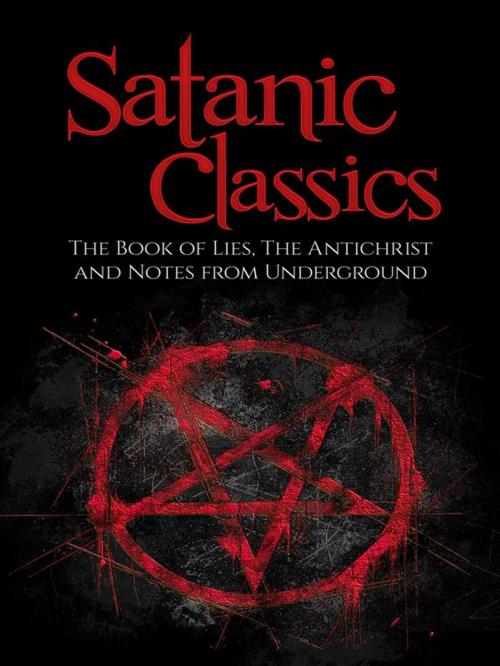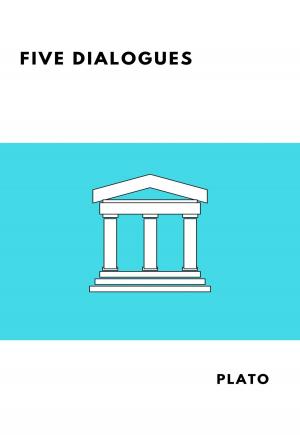Satanic Classics (Illustrated)
The Book of Lies, The Antichrist and Notes from Underground
Nonfiction, Religion & Spirituality| Author: | Friedrich Nietezsche, Aleister Crowley, Fyodor Dostoyevsky, Damian Stevenson | ISBN: | 9781387624324 |
| Publisher: | Logos | Publication: | February 25, 2018 |
| Imprint: | Language: | English |
| Author: | Friedrich Nietezsche, Aleister Crowley, Fyodor Dostoyevsky, Damian Stevenson |
| ISBN: | 9781387624324 |
| Publisher: | Logos |
| Publication: | February 25, 2018 |
| Imprint: | |
| Language: | English |
THREE MASTER WORKS FROM THE OFFICIAL CHURCH OF SATAN READING LIST
From the list originally published in Magistra Blanche Barton’s The Church of Satan as approved by Magus Anton Szandor LaVey.
THREE CLASSIC TEXTS FOR STUDENTS OF SATANISM AND THE OCCULT:
THE BOOK OF LIES by Aleister Crowley
“Teach us Your real secret, Master! how to become invisible, how to acquire love, and oh! beyond all, how to make gold.”
The esoteric masterpiece by one of the foremost mystics of all times. As Crowley describes it: "This book deals with many matters on all planes of the very highest importance. It is an official publication for Babes of the Abyss, but is recommended even to beginners as highly suggestive. Chapter 44 of the book describes the ritual named the Mass of the Phoenix.
The Book of Lies by Aleister Crowley, is a masterpiece of modern occult literature. There are numerous intriguing references: to the Tarot, the Qabala, astrology, Egyptian mythology, the "Left Hand Path," Masonry, the Beast of Revelation, sacred geometry, etc. Crowley's writing is often cryptic, often witty, often elegant. The book is also full of memorable quotes. Like the most enduring of occult and freethinking writers, Crowley challenges us to refocus our dulled organs of perception, and to rethink our stale mental conventions.
THE ANTI-CHRIST by Friedrich Nietzsche
***The Antichrist ***(also could be translated as The Anti-Christian) was originally published in 1895. It was actually written in 1888 but its controversial content delayed its publication, along with Ecce Homo.
Friedrich Nietzche (1844-1900) wrote ***The Antichrist ***(1888) after ***Thus Spake Zarathustra ***and shortly before the mental collapse that incapacitated him for the rest of his life. This work is both an unrestrained attack on Christianity and a further exposition of Nietzche's will-to-power philosophy so dramatically presented in Zarathustra. Christianity, says Nietzche, represents "everything weak, low, and botched; it has made an ideal out of antagonism towards all the self-preservative instincts of strong life." By contrast, Nietzche defines good as: "*All that enhances the feeling of power, the Will to Power, and power itself in man. What is bad? - All that proceeds from weakness. What is happiness? - The feeling that power is increasing, - that resistance has been overcome." *
NOTES FROM UNDERGROUND Fyodor Dostoevsky
Notes is considered by many to be the first existentialist novel. It presents itself as an excerpt from the rambling memoirs of a bitter, isolated, unnamed narrator (generally referred to by critics as the Underground Man) who is a retired civil servant living in St. Petersburg. The first part of the story is told in monologue form, or the underground man's diary, and attacks emerging Western philosophy. The second part of the book is called "Àpropos of the Wet Snow", and describes certain events that, it seems, are destroying and sometimes renewing the underground man, who acts as a first person, unreliable narrator. Written in 1864, this novel is the first and strangest of Dostoevsky's masterpieces--and the source of those that followed. Violating literary conventions in ways never before attempted, this classic tells of a mid-19th-century Russian official's breakaway from society and descent "underground."
*Newly edited and revised text.
*Handcrafted original images.
*Curated image gallery.
*Restored text of The Book of Lies with all original material.
THREE MASTER WORKS FROM THE OFFICIAL CHURCH OF SATAN READING LIST
From the list originally published in Magistra Blanche Barton’s The Church of Satan as approved by Magus Anton Szandor LaVey.
THREE CLASSIC TEXTS FOR STUDENTS OF SATANISM AND THE OCCULT:
THE BOOK OF LIES by Aleister Crowley
“Teach us Your real secret, Master! how to become invisible, how to acquire love, and oh! beyond all, how to make gold.”
The esoteric masterpiece by one of the foremost mystics of all times. As Crowley describes it: "This book deals with many matters on all planes of the very highest importance. It is an official publication for Babes of the Abyss, but is recommended even to beginners as highly suggestive. Chapter 44 of the book describes the ritual named the Mass of the Phoenix.
The Book of Lies by Aleister Crowley, is a masterpiece of modern occult literature. There are numerous intriguing references: to the Tarot, the Qabala, astrology, Egyptian mythology, the "Left Hand Path," Masonry, the Beast of Revelation, sacred geometry, etc. Crowley's writing is often cryptic, often witty, often elegant. The book is also full of memorable quotes. Like the most enduring of occult and freethinking writers, Crowley challenges us to refocus our dulled organs of perception, and to rethink our stale mental conventions.
THE ANTI-CHRIST by Friedrich Nietzsche
***The Antichrist ***(also could be translated as The Anti-Christian) was originally published in 1895. It was actually written in 1888 but its controversial content delayed its publication, along with Ecce Homo.
Friedrich Nietzche (1844-1900) wrote ***The Antichrist ***(1888) after ***Thus Spake Zarathustra ***and shortly before the mental collapse that incapacitated him for the rest of his life. This work is both an unrestrained attack on Christianity and a further exposition of Nietzche's will-to-power philosophy so dramatically presented in Zarathustra. Christianity, says Nietzche, represents "everything weak, low, and botched; it has made an ideal out of antagonism towards all the self-preservative instincts of strong life." By contrast, Nietzche defines good as: "*All that enhances the feeling of power, the Will to Power, and power itself in man. What is bad? - All that proceeds from weakness. What is happiness? - The feeling that power is increasing, - that resistance has been overcome." *
NOTES FROM UNDERGROUND Fyodor Dostoevsky
Notes is considered by many to be the first existentialist novel. It presents itself as an excerpt from the rambling memoirs of a bitter, isolated, unnamed narrator (generally referred to by critics as the Underground Man) who is a retired civil servant living in St. Petersburg. The first part of the story is told in monologue form, or the underground man's diary, and attacks emerging Western philosophy. The second part of the book is called "Àpropos of the Wet Snow", and describes certain events that, it seems, are destroying and sometimes renewing the underground man, who acts as a first person, unreliable narrator. Written in 1864, this novel is the first and strangest of Dostoevsky's masterpieces--and the source of those that followed. Violating literary conventions in ways never before attempted, this classic tells of a mid-19th-century Russian official's breakaway from society and descent "underground."
*Newly edited and revised text.
*Handcrafted original images.
*Curated image gallery.
*Restored text of The Book of Lies with all original material.















